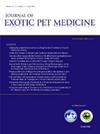Risk and protective factors associated with clinical urolithiasis in pet guinea pigs (Cavia porcellus)
IF 0.6
4区 农林科学
Q4 VETERINARY SCIENCES
引用次数: 0
Abstract
Objective
To determine potential risk and protective factors for the development of clinical urolithiasis in pet guinea pigs.
Animals
Approximately 242 guinea pigs (Cavia porcellus).
Methods
Signalment, dietary and medical history were recorded from urolith submissions from affected guinea pigs. The controls were identified via an online survey from owners of nonclinical pet guinea pigs, and data was collected regarding signalment, past medical history and diet. Clinical urolithiasis is defined as animals having or had the presence of uroliths identified via imaging, surgery, or manual expulsion, and control subjects may include subclinical or asymptomatic cases. Diets for control and affected subjects were assessed for percentage of pellets, hay, fruits/vegetables, high-calcium dietary items and vitamin C offered. Models were constructed with the best fit evaluated using Hosmer-Lemeshow tests. The 2 predictive models used, %hay (PH) and %pellets (PP), could not be combined due to their collinear nature.
Results
Data from 70 affected and 172 control guinea pigs were included in the analyses. Guinea pigs ≥24 months had higher odds of developing urolithiasis (PH: OR = 30.74; 95% CI [6.26–150.9], P < 0.001; PP: OR = 19.23; 95% CI [4.64–79.65], P < 0.001). Animals ≥1300 grams were more protected against urolithiasis (PH: OR = 0.05; 95% CI [0.0042–0.48], P < 0.010; PP: OR = 0.05; 95% CI [0.0045–0.47], P < 0.009). Affected males were overrepresented (62.8%, 44/70). Diets higher in %hay (PH: OR = 0.94; 95% CI [0.91–0.97], P < 0.001) or greater variety of fruits/vegetables (>7 types) (PH: OR = 0.66; 95% CI [0.57–0.76], P < 0.001; PP: OR = 0.69; 95% CI [0.61–0.80], P < 0.001) were more protective; guinea pigs with diets higher in %pellets were more likely to develop urolithiasis (PP: OR = 1.05; 95% CI [1.02–1.09], P < 0.003). High moisture (>50%) food items, such as bell peppers, tomatoes and romaine lettuce were especially protective against the formation of uroliths.
Conclusions and clinical relevance
Age, body weight, sex and dietary factors are important considerations for the development of clinical urolithiasis in guinea pigs and should be considered when tailoring preventative strategies for guinea pigs.
宠物豚鼠(porcavia porcellus)临床尿石症的风险及保护因素
目的探讨宠物豚鼠临床尿石症发生的潜在危险因素和保护因素。动物:大约242只豚鼠。方法记录感染豚鼠尿石的信号、饮食和病史。通过对非临床宠物豚鼠的主人进行在线调查,确定了对照组,并收集了有关信号、既往病史和饮食的数据。临床尿石症的定义是通过影像学、手术或人工排出术发现有或曾经存在尿石的动物,对照组可能包括亚临床或无症状病例。对对照组和受影响受试者的饮食进行了评估,包括颗粒、干草、水果/蔬菜、高钙饮食项目和维生素C的百分比。采用Hosmer-Lemeshow检验评估模型的最佳拟合。所使用的2个预测模型,%干草(PH)和%颗粒(PP),由于它们的共线性性质,不能组合。结果70只感染豚鼠和172只对照豚鼠的数据被纳入分析。≥24个月的豚鼠发生尿石症的几率更高(PH: OR = 30.74;95% CI [6.26-150.9], P <;0.001;Pp: or = 19.23;95% CI [4.64-79.65], P <;0.001)。≥1300克的动物更容易患尿石症(PH: OR = 0.05;95% CI [0.0042-0.48], P <;0.010;Pp: or = 0.05;95% CI [0.0045-0.47], P <;0.009)。男性患者比例过高(62.8%,44/70)。饲粮中干草含量较高(PH: OR = 0.94;95% CI [0.91-0.97], P <;0.001)或更多种类的水果/蔬菜(>;7种)(PH: or = 0.66;95% CI [0.57-0.76], P <;0.001;Pp: or = 0.69;95% CI [0.61-0.80], P <;0.001)保护作用更强;饲粮中颗粒含量较高的豚鼠更容易患尿石症(PP: OR = 1.05;95% CI [1.02-1.09], P <;0.003)。高水分(50%)的食物,如甜椒、西红柿和长叶莴苣,特别能防止尿石的形成。结论和临床相关性年龄、体重、性别和饮食因素是豚鼠临床尿石症发生的重要考虑因素,在制定豚鼠预防策略时应予以考虑。
本文章由计算机程序翻译,如有差异,请以英文原文为准。
求助全文
约1分钟内获得全文
求助全文
来源期刊

Journal of Exotic Pet Medicine
农林科学-兽医学
CiteScore
1.20
自引率
0.00%
发文量
65
审稿时长
60 days
期刊介绍:
The Journal of Exotic Pet Medicine provides clinicians with a convenient, comprehensive, "must have" resource to enhance and elevate their expertise with exotic pet medicine. Each issue contains wide ranging peer-reviewed articles that cover many of the current and novel topics important to clinicians caring for exotic pets. Diagnostic challenges, consensus articles and selected review articles are also included to help keep veterinarians up to date on issues affecting their practice. In addition, the Journal of Exotic Pet Medicine serves as the official publication of both the Association of Exotic Mammal Veterinarians (AEMV) and the European Association of Avian Veterinarians (EAAV). The Journal of Exotic Pet Medicine is the most complete resource for practitioners who treat exotic pets.
 求助内容:
求助内容: 应助结果提醒方式:
应助结果提醒方式:


